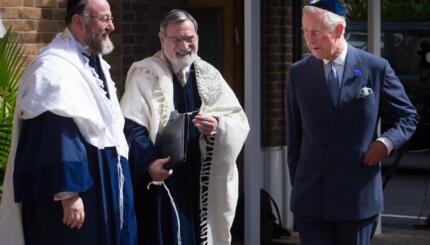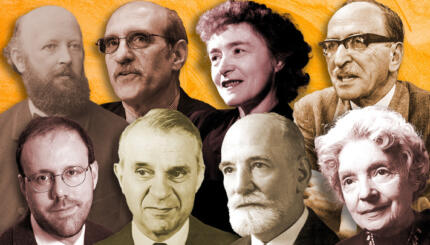Chapters in American Jewish History are provided by the American Jewish Historical Society, collecting, preserving, fostering scholarship and providing access to the continuity of Jewish life in America for more than 350 years (and counting). Visit www.ajhs.org.
Isaac de Castro lived in the Dutch-held section of 17th century Brazil, one of the earliest permanent Jewish settlements in America. The Dutch had conquered the northeastern provinces of Brazil from Portugal in 1630. Until 1654, when the Portuguese reconquered the area, several hundred European Jewish families migrated there and formed a vibrant community centered in Recife. The Dutch were tolerant of Judaism and, therefore, Recife attracted European Jews forced to practice their religion in secret while pretending to live as Catholics.
In 1641, at age 16, Isaac de Castro migrated from Amsterdam to Recife. In 1644, de Castro chose to move from the relative safety of Recife to Bahia, the capital of Portuguese Brazil, where he came under scrutiny by the Inquisition. Historian Arnold Wiznitzer speculates that de Castro moved to Bahia because he was an emissary sent by the Amsterdam Jewish community to Portuguese Brazil to encourage Jewish conversos living there to observe Jewish rituals. If Wiznitzer is correct, De Castro’s mission to these secret Jews cost him his life.
Soon after his arrival, someone denounced Isaac de Castro to Dom Pedro da Silva, the Bishop of Bahia, chief of the Portuguese Inquisition in the colony. The bishop’s informant recognized de Castro as someone he had seen visit the Recife synagogue. Brought before the bishop in December 1644, de Castro tried at first to evade punishment. He swore that he was Jose de Liz, a circumcised Jew born in France. De Castro (alias de Liz) testified that he developed doubts about Judaism while studying at a French university and came to Bahia to learn more about Catholicism.
In 1498, Portugal had compelled its Jews to convert or be expelled. In order to stay, many Jews chose outward conversion. Contrary to popular imagery, the Inquisition did not execute professing Jews who refused to convert. Rather, its targets were Jews who had accepted baptism and converted to Catholicism but who continued, secretly, to maintain or promote Jewish practices. Isaac de Castro tried to convince the bishop that he was not a baptized Christian, although he had a Christian education, and was thus outside the Inquisition’s jurisdiction. The bishop was having none of de Castro’s story. His Catholic Bible and were introduced as evidence of de Castro’s double life. The bishop ordered de Castro shipped to Lisbon, Portugal for formal adjudication.

Help us keep Jewish knowledge accessible to millions of people around the world.
Your donation to My Jewish Learning fuels endless journeys of Jewish discovery. With your help, My Jewish Learning can continue to provide nonstop opportunities for learning, connection and growth.
At his ecclesiastical trial in June 1645, de Castro finally admitted his correct identity. He was indeed the son of Portuguese conversos and had lived outwardly as a Catholic when the family moved to France. His mother told him, however, when he was supposed to undergo infant baptism, she substituted another child for him. For this reason, de Castro claimed, he felt free to practice Judaism without running afoul of the Inquisition. When the de Castro family moved to Amsterdam, Isaac, his brothers and his father underwent circumcision and openly reclaimed their Jewish identity. De Castro claimed that he migrated to Recife and then Bahia to avoid a murder charge pending in Amsterdam. Witnesses testified to the contrary that de Castro was sent to Bahia by the Jewish community to teach Judaism to the province’s secret Jews.
The tribunal believed the witnesses and found Isaac de Castro, who in their judgment had been properly baptized a Catholic, guilty of secretly practicing and proselytizing for Judaism. He was offered two choices: continue to deny Catholicism and be burned at the stake, or confess his errors, return to the Church and suffer a prison sentence not likely to exceed five years. According to Wiznitzer, de Castro understood that, to save his life, “he was expected to abjure Judaism and profess Catholicism as the vast majority of imprisoned apostates had done under similar circumstances.” To his credit, de Castro “decided that such a price for saving his life was too high and preferred to perish . . . for the sanctification of God’s name.”
The trial transcript records that, upon hearing of his conviction, de Castro indicated that he prayed to God seven times each day, observed the Jewish holidays and fast days, upheld the laws of and complied as best he could with the 613 mitzvot prescribed by the sages –while presenting the outward appearance of a Christian. For two years, priests attempted to convince de Castro that Christ was the Messiah and that he should accept Jesus as his savior. Frustrated by de Castro’s refusal, the clergy finally informed the court that he was incorrigible.
On December 15, 1647, de Castro was re-tried in criminal court and sentenced to death. Offered another chance to convert, he refused. Taken to the Square of the Royal Palace for public execution, de Castro was offered a final chance to embrace Catholicism so he might mercifully be strangled before being burned alive. He refused once again. Eyewitness accounts indicate that, as the flames rose, de Castro intoned the and then called out his final words, Ely, Adonai, Sabahot.


